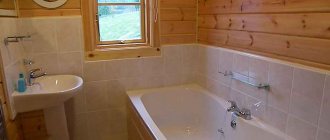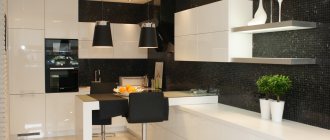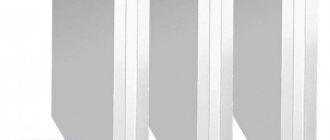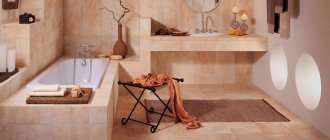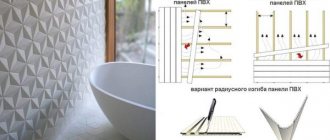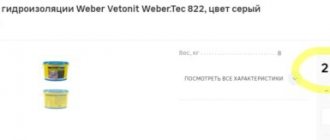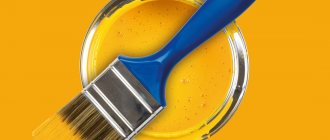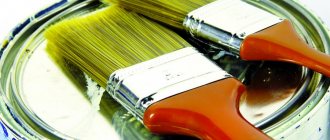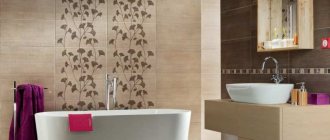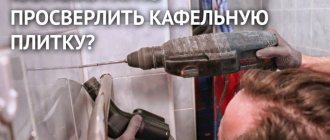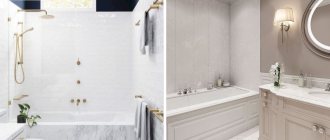Are you planning a major renovation of your apartment bathroom or are you building a bathroom in a private house? In any case, you cannot do without waterproofing the floor and walls for further laying of tiles, because these very rooms - the bathroom and toilet - need special protection from moisture. Waterproofing a room is important for at least two reasons. The first is the durability of the repair; any structure is destroyed by moisture, so protection is necessary if you do not want to make repairs in a few years. The second reason is to avoid trouble in the form of angry neighbors from the lower floor in the event of a leak in your apartment. Waterproofing in this case will also protect your neighbors from unexpected repair costs.
Why is it necessary to protect all structures?
The waterproof layer protects building and finishing materials from the destructive effects of moisture. The service life of floor and wall materials depends on the correct selection of waterproofing materials and the quality of work.
If you make a mistake, the finish will quickly become unusable, and the materials themselves will be infected with fungus, which is very difficult to remove.
This is one of the most popular waterproofing options, because... materials tolerate mechanical loads well, retain plasticity for a long time, and do not crack when structures settle
It is advisable to carry out high-quality waterproofing of all structures - floors, walls, ceilings. Ceiling treatment protects the bathroom from flooding by neighbors; floor – prevents water from seeping into the apartment below.
If everything is clear about the relevance of moisture protection of the floor and ceiling, then the need to insulate the walls sometimes raises doubts. Why is it needed? Waterproofing materials on the walls do not allow fungi and bacteria to multiply, preserve the finish, and prevent the occurrence of cracks.
Crevices in building materials, which can appear due to prolonged exposure to moisture, allow cold air to enter the room. This creates certain health risks for people who use the bathroom.
Dampness and cold air currents accelerate the destruction of building materials. As a result, the plaster deteriorates faster and crumbles, the paint bursts, and tiles fall off the walls and floors. Therefore, it is imperative to protect the walls at least in those areas where they are constantly splashed with water.
In the figure, areas that require particularly careful waterproofing are marked in blue. It is in these places that the greatest dampening of building materials is possible.
What is waterproofing and where is it needed?
The classic floor of any room looks like a multi-layer cake. It consists of a floor base, screed and decorative floor covering in the form of tiles, linoleum and so on. A caring owner or professional developer adds another layer to the pie - waterproofing. This layer provides protection from moisture (as the name itself suggests) and increases the durability of the entire structure. Water does not penetrate inside and, accordingly, does not have a destructive effect on the materials that make up the floor. Repair of such coating is postponed for a longer period.
The need for a waterproofing process arises if the overlap of the floor on the walls is at least 20-30 cm. In this case, special attention should be paid to the plumbing area in the room. In these places, it is better to cover the wall with waterproofing approximately 50 cm to the sides and up from the plumbing. Waterproofing is also necessary from the inside of the plumbing cabinet, where the risers are located.
Types of waterproofing materials
To choose the right waterproofing for bathroom floors and walls under tiles, you should understand the types of insulating materials. They are purchased based not only on prices, but also on the structure, properties of coatings, and predicted loads.
Possible options:
- coating compounds;
- adhesive waterproofing – roll, film, bitumen materials;
- special hydrophobic plasters;
- waterproof paints;
- impregnating waterproofing;
- rubber-based compounds.
For waterproofing a bathroom under the tiles, coating, pasting, penetrating materials, and rubber-based compounds are suitable. It should be noted that polyethylene films are rarely used to protect bathrooms from moisture.
With all its advantages and affordable price, polyethylene is the worst choice for the bathroom. The material does not have good vapor permeability. This makes it unsuitable for use in a bathroom - an enclosed space with high humidity and specific temperature conditions.
The finishing of the floor and walls consists of several layers, incl. and waterproofing. Its thickness and functionality depend on the materials chosen
An important point: the joints between the floor and walls and the junction of the bathtub and the wall need careful waterproofing. Many materials are difficult to apply tightly in corners, so sealing cords or tapes should be selected.
Sealant cords are made of hygienic materials that prevent the growth of fungus and mold. They are laid at the joints, firmly glued to the surfaces, and covered with a fine finish. Such a cord can last for decades.
How to lay the tape or sealant cord is shown in the video:
Which waterproofing is better?
[smartcontrol_youtube_shortcode key=”bathroom waterproofing choice” cnt=”4" col=”2" shls=”true”]
It’s difficult to say unequivocally which waterproofing under tiles will be optimal in a given case. For greater clarity, you can compare all the methods of waterproofing walls and floors under tiles in the bathroom.
| Type of waterproofing | Positive sides | Negative sides |
| Coloring | · takes up little space, does not reduce the volume of the room; · speed; · low cost of materials; · versatility; · the layer is smooth and thin, but without joints | · fragility; · substances with a pungent odor are used for dilution; there is a risk of toxic poisoning when applied; · For some time after applying the waterproofing, toxic fumes are released; · cannot be used in a room with “warm floors”; fragility (easily damaged) |
| Coating | · versatility; · strength and durability; · no additional concrete screed required; · high level of adhesion to glue; · it can be used to smooth out small bumps and holes on the floor and walls | · the area of the room decreases, slightly; · short pot life of the solution, all operations for applying waterproofing must be performed quickly |
| Pasting | · thin layer; · reliability; · waterproofing does not reduce the size of the room; · versatility | · additional equipment (burner) is required; · if handled carelessly, the sheets may tear; · can only be installed in well-ventilated areas where gas will not accumulate; · weak point – seams, they require additional reinforcement; Can be torn or scratched when laying tiles |
| Fill | · very durable and reliable waterproofing; · ideal waterproofing of floors under tiles; · no concrete screed required; Can even out all floor imperfections | · the floor level rises significantly; · reducing the area of the room; This waterproofing is used only for floors |
| Waterproofing composition | · ease of application of waterproofing; · high speed of work; Can be used on walls, i.e. where water does not stagnate | · low efficiency (compared to other waterproofing methods); · the material is not suitable for floors |
| Sputtering | · thin and durable protective layer; · the dimensions of the room do not change; · the material reliably holds water | · requires careful handling and accuracy when laying tiles, since the resulting film can be torn; · it is not possible to apply it in all rooms; · special equipment required |
As you can see, each material has its own specifics. This must be taken into account when choosing.
Main requirements for the quality of moisture protection
Waterproofing materials must be applied so that after drying they form a complete coating without gaps, so all work is carried out in a relatively short time.
If the coating is two or three layers, the next layer is applied immediately after the previous one has dried. This allows you to achieve the best adhesion of materials. Time intervals are minimal.
When using rolled materials, you must comply with the overlap dimensions provided by the manufacturer. When insulating floors at the joints with walls, it is necessary to remove the material to the walls.
Regardless of what materials or compositions are chosen for insulation work, they must all be applied to clean surfaces. To reduce material consumption and improve adhesion, primer mixtures are used.
When insulating a bathroom floor, you need to pay special attention to the corners. Here the coating should adhere well to the surfaces and form a single carpet
Features of waterproofing a wooden room
For a bathroom whose walls and floors are made of wood, you cannot use all the options discussed above. Let's figure out how to properly implement moisture protection in such rooms.
How to properly protect wooden floors?
For bathrooms in wooden buildings, it is not recommended to use insulation with a concrete screed. It increases the load on the foundation and increases heat loss. For this reason, the main method of arranging the floor is lag, which, if necessary, is insulated, following the correct technology. Read about floor insulation using joists in this article.
Even at the stage of planning a house, you should provide flooring in the bathroom below the general level by about 10 centimeters. This will create the necessary barrier for water to penetrate into other rooms in the event of a leak.
One of the common options for field insulation in this case is coating.
The lag floor option involves coating the foundation and using moisture-resistant insulation in the cavities between the lags
Before applying the mastic, preliminary preparation is necessary:
- all cracks and holes are sealed with special mastic for wood;
- the floor is thoroughly cleaned;
- treated with impregnation with antiseptic properties, which will prevent the occurrence of mold;
- A mandatory step in preparation is the primer, which increases adhesion to the insulator.
If leveling is necessary, you can use sheets with a cement-bonded particle base, which are laid in two layers. When the preparation is completed, the floor is given time to dry, and the main work begins. First of all, insulate all joints using special tape.
Next, the first layer is laid using a roller; a spatula or brush is used in the corners. After it dries, which takes about 6 hours, apply a second layer strictly perpendicular to the first. The insulation is dried during the day, then tiling work is carried out.
Creating a barrier for wooden walls
Just as in the case of the floor, the walls must be pre-treated with an antiseptic, any existing cracks must be sealed with mastic. The surface can be treated with wax, which will protect the wood from deep penetration of moisture.
Next, apply a double layer of primer, increasing its density closer to the ceiling, where condensation usually accumulates. After drying, roll materials are laid or coated.
In the latter case, the work is performed as follows:
- before application, leveling of the surface will be required, which is achieved using plaster along beacons using a level;
- the corners are also insulated with tape;
- The mastic is applied with a brush or spatula with a wide profile.
If partial tiling is planned, the areas around the sink, toilet and bathtub are coated with three layers of mastic. Each of them is applied after the previous one has dried. The tiles are laid on completely dried insulation.
The walls in a wooden bathroom can be insulated with any material, including rolls, but coating mastics are most often used
High-quality waterproofing materials, applied correctly, will ensure reliable protection of walls and floors from moisture. But to achieve maximum results, it is equally important to use reliable sealants when installing plumbing fixtures, carefully sealing all joints.
What materials to choose for waterproofing walls?
To waterproof bathroom walls under tiles, several different types of materials are used:
- Bitumen and polymer mastics. A very popular waterproofing option. Simple application technology, efficiency and durability make it extremely popular. Mastics of many brands are universal and suitable for premises of any purpose.
- Impregnating. These are liquid compositions that are applied to the base with rollers or cysts. They are easy to use and last as long as the building material with which it was processed. At the same time, the base is strengthened and its service life is extended.
- Membrane. When choosing membranes, you should carefully read the scope of application of a particular material. The instructions must clearly indicate that the membrane of this brand is suitable for internal waterproofing of premises. It is undesirable to choose films that are too dense, because... they are less elastic.
- Expanding cement. It increases in volume as it hardens. Thanks to this, cement fills the slightest cracks and crevices, reliably sealing them and preventing moisture from entering.
Before starting work, remove old coatings and clean the base down to concrete. Only after this the surfaces are leveled and prepared for waterproofing.
What is better to use for waterproofing a bathroom? Coating and impregnating compounds are often chosen for tiles.
To apply them, you don’t have to hire professional builders; all the work can be done yourself, and this is a serious cost savings.
In recent decades, finishing panels that initially have water-repellent properties have become popular.
The only disadvantage of this type of waterproofing is the high cost, but if the budget allows, then this is an excellent option, because the panels will last for several decades.
Features of installing moisture-resistant panels are described in the video tutorial:
Types of moisture-proof materials for the bathroom
There is no shortage of special moisture-protective products on the shelves of construction stores. It will be difficult for an ignorant buyer to make a choice if they do not know their types and purpose.
Materials are mainly divided according to the components used for their manufacture, structure, and specific properties:
- mastic applied by coating surfaces;
- roll devices , which are applied by pasting;
- pastes and liquids;
- penetrating mixtures used for application to porous substrates.
In addition to the listed materials, powdered mixtures intended for creating waterproofing solutions by dilution are suitable for moisture protection of bathtubs.
If the walls are uneven, you can use special plaster; in addition to being resistant to wet environments, it will ensure leveling of the surface. Finally, for the same purposes, a film made of polymers or rubber is often recommended, which is applied by spraying and forms a powerful barrier after drying.
Penetrating insulation prevents the absorption of moisture by porous surfaces from the inside and outside, ensuring the safety of the base
When choosing a suitable insulator, you need to focus on the recommendations of the instructions, which usually indicate the scope of application of a particular product. You should choose materials recommended for use in interior spaces.
What is suitable for protecting the floor from water?
What materials are best to choose for waterproofing a bathroom floor under tiles? By and large, almost any will do, depending on the preferences of the owner and his financial capabilities. It is important to consider the service life so that the waterproofing lasts no less than the finishing.
Rolled waterproofing materials can be laid under a concrete screed, but coating materials are often used instead, because they are more convenient to use and create a durable elastic protective layer. They can be applied both under the concrete screed and on top of it.
Coating compounds combine well with penetrating waterproofing. In this case, the base under the concrete screed is protected with a coating composition, and the finished screed is impregnated with a penetrating composition.
This guarantees 100% protection against any floods.
Modern roll materials are easy to install. For gluing them, special adhesive tapes are provided that securely fasten the strips
What else should you pay attention to when choosing a waterproofing method?
In addition to the specifics of materials, a number of factors and parameters need to be taken into account:
- Features of the room, so not all methods of waterproofing can be used in small rooms.
- Wall and floor material: concrete, fiberglass board, GVLV, wood or others.
- In some cases, it is impossible to raise the floor even a centimeter, then pouring and putty will not work.
- Features of the technology if you plan to carry out waterproofing work on your own. For example, difficulties will arise with spraying, since it requires special equipment and skills to work with it.
- Allergy sufferers and people sensitive to odors should not work with toxic materials.
- The bathroom does not require global waterproofing; everything should be done in moderation.
- How much do materials cost and their consumption: repairs should be affordable.
Waterproofing bathroom walls and floors under tiles is not an easy task, requiring careful attention and careful weighing of all the pros and cons.
Popular bathroom waterproofing technologies
If you plan to do all the work yourself, it makes sense to choose the most affordable materials, the installation of which does not require expensive equipment or special skills.
The video shows a lesson on waterproofing a bathroom, which describes the general procedure of work step by step:
Option #1: using roll materials
To waterproof the bathroom floor under the tiles, you can choose fiberglass or fiberglass. These are quite expensive materials, but they do not have the disadvantages inherent in traditional roll waterproofing - roofing felt, glassine, etc.
Fiberglass and fiberglass are not subject to rotting, making them practical and durable. However, they have their drawbacks. When rolling out rolls and installing strips, be careful not to tear them.
There are three main installation technologies. They vary in complexity and equipment used:
- Fastening. This method is not particularly popular. Fasteners will be required. The rolls are mounted on the subfloor and the pierced areas are carefully insulated.
- Deposition. To fuse the material you will need a heat gun. This equipment is used in enclosed spaces - where gas burners are not applicable. Fused materials are used relatively rarely for waterproofing bathrooms.
- Pasting. This is the best option for arranging moisture protection. The materials are glued using bitumen-polymer mastics or adhesives. Mastics create an additional protective barrier. When choosing them, you should pay attention to the temperature conditions at which the materials retain their properties.
Before starting work, the cut strips of material must “rest” for 24 hours. This is necessary so that they align and bubble less when laying.
Procedure for gluing waterproofing:
- The base is checked using a level. If necessary, level with concrete screed. The joints of the floor and walls are rounded so that the material does not crack during installation. After this, the base is thoroughly cleaned of debris and dust, dried, and primed.
- The rolls are cut into panels of the required length. The finished strips are rolled out and treated with solar oil (it cleans and promotes greater elasticity), and left for a day.
- The base is covered with mastic chosen for gluing the rolled material.
- Strips are glued onto the mastic with an overlap of about 10 cm, unless the manufacturer’s instructions for the material contain other recommendations.
- Bubbles formed during installation are carefully cut, the edges of the material are folded back, coated with mastic and glued back to the base, smoothed.
- To improve the adhesion of the waterproofing to the next layer - concrete screed, it is coated with mastic on top and sprinkled with coarse sand.
When waterproofing the bathroom floor with rolled materials, the joints of the floor and walls are finished by placing strips on the walls by 15 cm
Option #2: coating waterproofing device
There are many types of mastics for waterproofing. The most popular are bitumen-containing, polymer and cement-polymer. All of them fill pores and cracks well, and after hardening they form a dense water-repellent layer.
For rooms with a complex configuration, it is best to choose coating waterproofing, because... mastics are easy to apply to protrusions. When buildings shrink, the coatings do not crack and reliably protect surfaces for many years.
Bitumen-containing mixtures are popular, affordable and have many other advantages. However, for the bathroom it is better to choose polymer or cement-polymer ones, because... they are less harmful to health and do not emit toxic substances
The application technology is simple:
- The surface to be treated is cleaned, dust-free, leveled if there are differences of more than 2 cm. To improve the adhesion of materials, the base is moistened with clean water or primed.
- The simplest option is to use ready-made compounds. If a dry mixture is selected, then it is diluted with water at room temperature in the proportions recommended by the manufacturer and mixed until a homogeneous mass is obtained. After this, leave for 3-5 minutes and mix again.
- The mastic should be used immediately. It is applied in two layers, and the corners and joints are finished with tape, carefully pressing it into the waterproofing layer.
- A reinforcing fiberglass mesh is laid on top of the finished coating. When the material dries, apply the last layer of mastic, completely covering the mesh without gaps.
The video shows the main stages of work with a description of the technology:
Option #3: plaster waterproofing
For plaster waterproofing, mixtures with polymer additives are used to improve the properties of materials. The most famous brands are Knauf and Ceresit. These are time-tested, high-quality mixtures that are excellent for treating surfaces in bathrooms.
Important! When choosing waterproofing, give preference to materials of the same brand. They fit perfectly and complement each other. For example, when working with the Ceresit CR65 mixture, you should buy a Ceresit CL52 sealing tape.
Composition application technology:
- The surface of the base is prepared: cleaned, treated with primer.
- Corners and joints are sealed with special tape.
- Prepare a solution and apply it to the surface in one direction, and the next - in a direction perpendicular to it.
- Waterproofing is made in two or three layers.
Compositions for plaster waterproofing are universal. They can be used for any finishing materials, incl. ceramic tiles
Option #4: impregnating compounds
Impregnating waterproofing materials include compositions based on bitumen, polymers, liquid glass, etc. They are united by a common property: they impregnate the base, strengthening its structure.
Impregnating compounds form hydrophobic compounds that change the characteristics of building materials. As a result, concrete or brick acquires water-repellent properties and becomes compacted.
Impregnating waterproofing also includes penetrating waterproofing. Among our compatriots, the materials of the Penetron system are deservedly popular. These are several types of mixtures intended for different types of work, and polymer repair tapes.
The advantage of penetrating materials is that they can be used not only to install new waterproofing, but also to repair old ones that have lost their properties.
Application technology:
- The base is prepared: cracks and seams are sealed; cleared of debris. Further preparation depends on the type of material and the manufacturer's recommendations. Before using Penetron, the surface is often wiped with 9% vinegar, dried, and then moistened generously.
- If a dry mixture is used, it is diluted according to the instructions. The quantity should be such that the solution is enough for 30-40 minutes of work. After this time it becomes unsuitable for use.
- The waterproofing composition is applied with a brush or roller. After the first layer has set, the surface is treated again.
- Complete drying time depends on the selected composition. If Penetron is used, it will take three days. During this period, the surface is regularly moistened to ensure good crystallization of the resulting compounds.
Some useful tips from a specialist:
Where should it be used?
First of all, you need to find out which areas of the room need to be waterproofed. This:
- the entire floor surface extending onto the walls to a height of at least 20 cm;
- the entire ceiling area, this will to some extent protect the apartment from leaks from the apartment located above. In addition, the presence of waterproofing on the ceiling will protect the supporting structures from damage caused by moisture evaporation. This is especially important for a wooden house;
- the surface of the walls in the area where sewer risers and water pipes are located;
- the surface of the walls near plumbing fixtures.
Advice! The moisture protection area of walls near plumbing fixtures should be at least half a meter in each direction.
Final conclusions
There are many materials for waterproofing a bathroom, and it is difficult to decide which is best suited for tiles. However, you can choose based on the basic properties of the finished coatings.
Thus, it is strongly not recommended to use painting compounds under the tiles. They are short-lived and will last less than the finishing material. When the waterproofing layer is destroyed, fungus may appear in the bathroom, and the tiles will peel off.
If the choice is made in favor of penetrating waterproofing, then it must be taken into account that it is used only for concrete foundations. It is not effective when used on stone or brick surfaces.
To waterproof a bathroom floor, it is better to choose lining materials in combination with high-quality mastics. Such protection will last for several decades, but it can only be used under a screed.
Coating
Coating waterproofing is one of the simplest, safest, and therefore popular types. It is very similar to ordinary plaster. The working solution is prepared in a similar way: a ready-made mixture consisting of sand, cement and polymer additives is purchased (usually sold in paper bags, packaged in 5, 10, 15 or 25 kg) and mixed in a certain proportion with water. The prepared waterproofing solution is applied to the walls with a spatula and “coated” them. The mixture tightly plugs the smallest pores and cracks in concrete and fiberboard. The solution can be applied to the bathroom floor, walls and even the ceiling.
The putty dries within a day, i.e. the next day you can start laying the tiles, since in this case a concrete floor screed is not required. However, when working, it is necessary to remember that the viability of the solution is short, it sets in just a few minutes, so all work must be done quickly.
Price
- Mapegum WPS, 5 kg - 2240 rub.
- Ceresit CR 65, 25 kg - 1040 rub.
- Toiler TR 500, 3 kg - 420 rub.
- MasterGood, 14 kg - 2600 rub.
- Osmoseal, 25 kg - 3800 rub.
- Nanodefens, 15 kg - 1900 rub.
- Hidroflex, 5 kg - 5300 rub.
- “Ivsil Vodostop”, 20 kg - 504 rub.
- “Glims Waterstop”, 20 kg - 1150 rub.
Waterproofing is the most important stage of finishing work in the bathroom. A waterproof barrier will protect building structures from exposure to moisture and the development of mold when tile seams are depressurized and will prevent water from entering the underlying rooms during flooding. After familiarizing yourself with the recommendations outlined, choosing and laying the material will not be difficult.
Review of the best manufacturers of insulating materials
An example of the most popular types of coating waterproofing.
Different types of waterproofing have different technical characteristics and service life. Which ones are better to choose? First of all, you should pay attention to the manufacturer. Among the best manufacturers of insulating materials are:
Knauf
Knauf is one of the most conscientious manufacturers of waterproofing materials. The Bavarian company specializes in the production of liquid formulations that contain chemically inert fillers and latex components with a low water absorption coefficient. The advantages of Knauf products include:
- Physiological safety and absence of unpleasant odor;
- High resistance to temperature changes (from -20 to +60 degrees);
- Waterproof;
- Microbiological resistance.
Ceresit
Ceresit is a Polish company that produces almost all existing types of waterproofing materials:
- mastics;
- film materials;
- hydrophobic liquids;
- polymer cement mixtures.
The advantages of Ceresit insulators include:
- high adhesion to the base;
- low water absorption coefficient;
- low cost;
- frost resistance;
- mechanical strength;
- chemical inertness.
In the process of producing waterproofing materials, the manufacturer Ceresit uses special polymer additives and plasticizers that improve the technical performance of insulating coatings.
When choosing waterproofing materials for finishing the bathroom floor, you should give preference to liquid or roll coatings. They have better heat and moisture resistance compared to other insulators. To reinforce your knowledge about waterproofing materials, watch the video.
Video description
About mistakes when waterproofing premises in the video:
Stages of work
For walls there is also a preparatory stage, which has almost the same appearance as for the floor:
- cleaning of old coating;
- correction of surface defects;
- applying a primer with hydrophobic and antiseptic properties.
After the soil has dried, apply a waterproofing solution with a spatula or trowel and spread it evenly over the wall. And since this is not putty, a perfectly flat surface is not needed here - small unevenness and roughness is compensated by a layer of tile adhesive.
Even moisture-resistant drywall needs to be protected Source finkarus.ru
